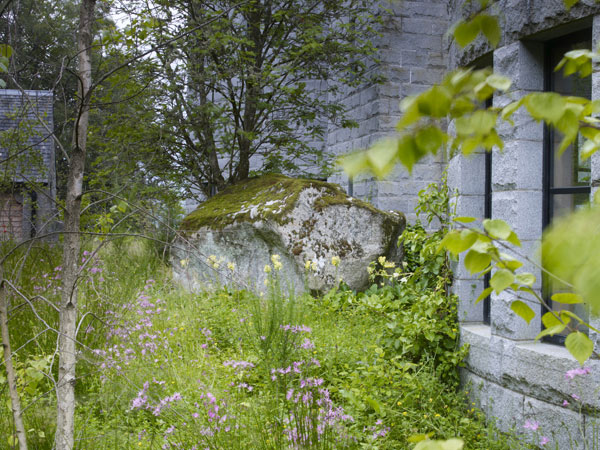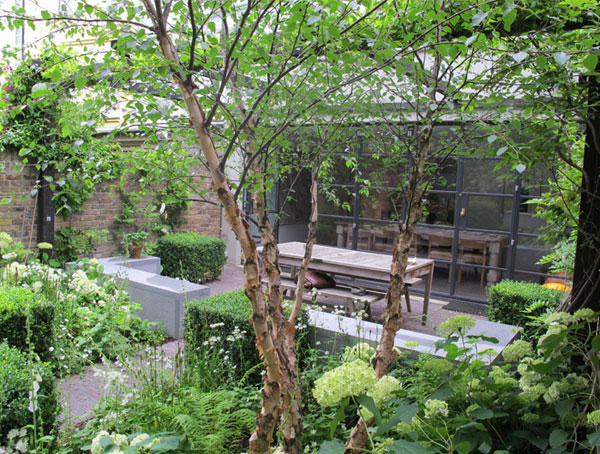News
Interview with Jinny Blom
 Jinny Blom / copyright N. Jouan
Jinny Blom / copyright N. Jouan
You’re just about a household name in the UK for your gardens, which go from the seemingly wildly romantic to somewhat intellectual and contemporary. You’ve said design is "more a matter of intelligence and appropriateness than reflecting a style." So there is no Jinny Blom style? And if not, is there a set of principles or ethics that guide your work?
I don’t think I have a style. I am me and I like certain things. They’re probably all things that repeat like certain plants but I wouldn’t say that was a style. I think it is much more about having a philosophy. It sounds terrible when you say it, but it's about local appropriateness. In England, certainly in British Isles, we’ve got very strong architectural precedent in each county. The land changes so distinctively as you move around from flint to limestone to clay. I like to use the materials that come up out of the ground. Things feel comfortable if they look as though they’ve been generated from their point of origin. In London or in other cities, you can do something more contemporary and abstract, but it would still follow those principles. I always think: good materials, good thinking. I’m a real sucker for good thinking.
In an interview with Garden Design Journal, you said, “it's vital to my own happiness that birds, insects, mammals, fish, and humans can coexist in the environment I'm creating.” How do you design spaces to ensure this will happen?
That’s just linking what one does with the surrounding environment. If you feel like you’re blocking animals, don't do it. I live right in central London and we’ve got a huge fox population. Animals have very specific routes that they like to take. They were taking a route that I didn’t really want them to take across my garden. So, I just redesigned the garden to accommodate the fox route and then it seems to work. Instead of like, oh the foxes, they’re driving me crazy running through my flower beds, you go, there goes the fox on his little fox route.
You can use that principle if you study the landscape reasonably well. I plant a lot of hedges so that animals can conduit their way easily from one way place to another. Nobody would know that I was doing it. It’s a subliminal thing. I always put water in if I can. I just think it's rude not to allow space for other creatures to be. If they can be, then everybody’s happy. A lot of my clients will say things like, look the birds are back. They notice. If you take away where the birds can live, then they won’t come.
 Image credit: Temple-Guiting / copyright Andrew Lawson
Image credit: Temple-Guiting / copyright Andrew Lawson
For one of your large-scale projects, Corrour in the Scottish Highlands, you created an "anti-garden," an "experimental approach to non-interventionist gardening." What does that entail? How did that work at that site?
The Highlands of Scotland are really interesting. That particular estate is 1,300-foot above sea level. It’s completely overpopulated with deer because people mainly go up there to hunt. The deer management has taken a turn for the worst so there are more deer than there is land to support them. It’s a very fragile land so they just graze everything off. When I first went up there, people said nothing will grow here. And I thought, well, of course, it will grow. The first thing we have to do is really release grazing pressure to see what would happen.
The whole project was interesting. I was working with the architect on the project, a guy called Moshe Safdie, who’s very well known over here or all over the world perhaps. He built such a strong Moshe building in this landscape. In a way, that made me want to rebel against doing anymore landscaping -- hard landscaping. So, it was a combination of studying the land and this over-grazing issue and how to address a response to this really anachronistic building in that environment. The best way to do it was to maroon the building in pure landscape, pure highland landscape. So, that’s really how it came about. And then my client and I just thought it was hilarious because we’re both women and instead of growing a set of balls to compete with Moshe's house, we just decided to subvert it.
 Image credit: Corrour / copyright Allan Pollock-Morris
Image credit: Corrour / copyright Allan Pollock-Morris You’ve done lots of memorable public projects, which appear at garden shows and even as temporary installations. One I was really struck by was the Laurent-Perrier Garden, which is actually really deep, too. How does the garden represent the journey of life?
I made that for Chelsea Flower Show for Lauren Perrier in 2007. Apparently everybody’s sick of gardens having a journey theme now. I didn’t realize I’d tapped into some zeitgeist there. I’m a transpersonal psychotherapist so I’m interested in people’s evolution and growth. The thing is we’re all on a one way trip. At that point my niece had just become very ill and nearly died, and then she didn’t die, and then she got pregnant and had a baby. It was all just very, very quick. I just thought this is amazing. There are these highs and lows in life, literally.
I love the architecture of Carlo Scarpa. I just thought I’m going to swipe one of his nice details. He did a very nice gallery in Venice and just made these panels that allow the canal waters to rise and fall. So I made the journey quite solid. It was travertine marble on concrete bases. All the planting is more emotional, intuitive, perceptive, with a moving aspect. Our journey is really sort of structured by huge events that sort of change your direction, so the panels all flip direction. One of them was a dead end, so it was like a maze. It was also a metaphor for my marriage (laughs). We went down the dead end bit. You have to retrace your steps and go down the other bit.
 Image credit: Laurent-Perrier Garden / copyright Gary Rogers
Image credit: Laurent-Perrier Garden / copyright Gary RogersOne of your small scale projects I really like is the Notting Hill Garden. How did you make this small space work?
City gardens are really a discipline. It’s like designing jewelry. I always think they’re like jewelry. My client had just put in some beautiful glazed doors that ran the full width of the house. The garden is probably 30 by 30 foot. They’re Australian and entertain a lot and wanted to cook outside. And I said, "yeah but you don’t want to be sitting in your beautiful house looking out at a kitchen." I just found a way making a very simple language of blocks that I built up. I found a barbecue that is amazingly discreet. It’s very high tech and very beautiful but it’s very discreet. It can disappear. It has no profile because normally they have huge great hoods, wheels and tongs, and god knows what. So, I just turned it around so it didn’t face the house. If you’re sitting inside and you’re looking out, you don’t want to be looking at it. So, really, the whole garden is a series of monolithic blocks, one of which, hey presto, has a fridge and plate rack.
 Image credit: Notting Hill Garden / copyright Robert Straver
Image credit: Notting Hill Garden / copyright Robert Straver You’re now on the board of the Therapeutic Landscapes Network. In one of your past lives, you were actually a psychologist. How are the practices of landscape architecture and psychology converging? What can landscape architects and designers learn from the latest psychological research? Conversely, what can the psychological community learn from landscape architects and designers?
Well, this is a subject very close to my heart, but I wouldn’t say I’m the go to person for the technical information. I think the Therapeutic Landscape Network web site itself has incredibly good research. Naomi Sachs, ASLA, who set it up, has just put together such a good board and such a good collection of contributors that I just point people to look at the site for those specific answers. But there’s no question in my mind that good landscaping has a good effect on human beings. A lot of urban architecture, landscape architecture needs to soften up.We’re still building too much.
The half French side of me says look at the Jardin des Tulieries in the middle of Paris. Paris is a very, very built up city, but the fact that they use soft finishes changes everything about the feel of the place. You know, it’s graveled throughout instead of paving. You look anywhere in the Mediterranean, in Europe: they’re much softer in their approaches to urban space. That just has an effect on how one feels. You feel like you’re on holiday. You feel more relaxed. I just feel that we could soften it all up again. Make urban landscapes gentler and more human. Less stuff, less product.
You've also said gardens and gardening should be described as being therapeutic as opposed to healing. What’s the difference? How are these gardens therapeutic for war veterans and those suffering from post traumatic stress disorders?
Therapeutic doesn’t imply that you can fix it. It implies that you can make some environmental improvements and give somebody an engagement that’s going to bring them some benefit. Whereas the word healing kind of implies that you’re going to put on your long white robe and touch somebody with a wand and make everything better. I just think there’s a big difference in assumption about what you can do with somebody who’s very damaged. I worked for a long time with very damaged people and know that environmental engagement has a huge benefit.
I’m trying to work at the moment with a colleague of mine on setting up a maintenance company using guys coming back from Afghanistan. Well, for purely mercenary reasons because it's so hard to find good workers! They’re trained. They’re competent. They know how to follow orders. They know how to turn up on time. They know how to tidy up after themselves. They want to work. And they’re not all suffering post traumatic stress, but they are nevertheless traumatized by their experience. It’s very difficult to leave the army, which is an incredibly structured environment, and go into an unstructured civilian environment. The great thing about gardening is that you’ll become sucked into the diurnal motion of the earth. If you’re having to dig and dig and dig, you have to be connected to earth and seasons. If you’re growing food for yourself, you want your potatoes to do well, so you create a relationship with your potatoes. You might not be able to have a relationship with your wife or your kids, but you can create a relationship with your spuds because you want to eat them at the end of the week and you don’t want to see them shriveling up in the sun. It’s a different emotional bonding.
There’s a really, really good book by Kenneth Helphand, FASLA, an American professor of landscape architecture, about war trauma and gardens. He did a whole thesis on it. It’s very interesting reading because people garden. They garden at the front in first World War. They garden in Chechnya now. There are people gardening in the ruins of that town just shot to bits. It’s a very primal urge somehow. The earth does neutralize a lot of human anxiety.
And I used to do it myself in my past. It’s worked for me. I was very troubled when I was younger and I’m not now. I’m a gardener so I do know about it firsthand as well. I know through working with the schizophrenics I used to work with, when I was director of the charity, that gardening was a massive help. Massive. I don’t say help in an over-weaning sort of way. It just made a difference. I don’t overstate it. I just think, go, and do it. It’s a simple thing that you can do on your own to alter the balance of your life.
Jinny Blom is one of the leading garden designers in the United Kingdom. Her work has been featured in the The Guardian, The Telegraph, Gardens Illustrated, House & Gardens, Vogue, and other publications. Blom is on the board of the U.S. Therapeutic Landscapes Network.
Interview conducted by Jared Green.